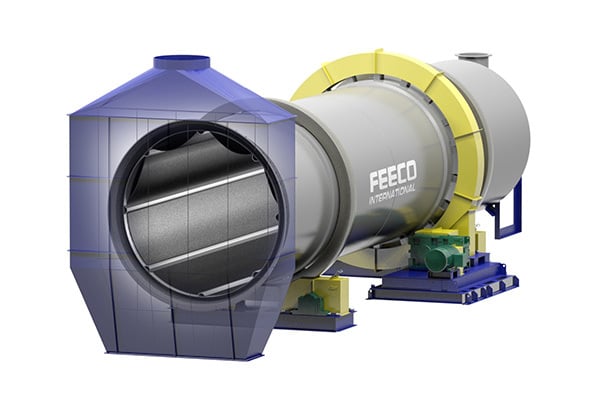Made up of sylvite (KCl) and halite (NaCl), sylvinite is an evaporite mineral that serves as the world’s primary source of potash – a nutrient critical to maintaining global food security.
Froth flotation is widely used for separating KCl from NaCl and other undesirable components such as carnallite and gangue in the beneficiation of potash. Because the flotation process relies on the hydrophobic and hydrophilic interactions between materials, however, enhancing these relationships is essential to maximizing potash recovery. For this, the potash industry (as well as many other mineral processing industries) relies on a conditioning step, particularly when it comes to coarse ore particles. While coarse conditioning can be carried out using various types of equipment, the coarse conditioning drum has become the industry standard for several reasons.
Note that despite the same name, this conditioning process is distinctly different from the conditioning process used as a finishing step in the production of granular potash fertilizers (glazing).
Preparation for Conditioning
The flotation process (and subsequently the conditioning process), can vary considerably across facilities. In general, however, potash typically goes through the following steps prior to conditioning and flotation:
Size Reduction
If necessary, potash ore goes through a size reduction and screening process to obtain the desired particle size range.
Separation
Coarse and fine ore fractions are typically separated to maximize the efficiency of the conditioning and flotation processes. Fines may or may not be conditioned, but coarse ore is generally always conditioned. (For this reason, operations not conditioning fines may refer to the conditioning process generally as coarse conditioning, or rougher conditioning.)
The coarse and fine ore fractions may or may not be recombined for flotation.
Desliming (Scrubbing)
The ore is deslimed, a process carried out in a rotary scrubber, which serves to remove slimes that would otherwise interfere with the flotation process.
The ore, now in the form of a pulp, is ready for conditioning.
About Potash Coarse (Rougher) Conditioning
Also called reagentizing, conditioning is a critical step in potash froth flotation (and also in many other industries that use froth flotation, such as when liberating phosphates). Conditioning combines various reagents with the pulp in order to enhance the hydrophobic or hydrophilic nature of the materials, ultimately improving separation efficiency during flotation.
The separate conditioning of coarse ore particles is important to ensure adequate contact of the reagents with the coarse ore fraction; fine ore fractions would otherwise consume the bulk of reagents (which are added in very small amounts), depriving the coarse ore fines of adequate reagent coverage and reducing recovery.
A depressant reagent such as guar gum works to suppress the undesirable fraction and any remaining slimes, while amine collector reagents promote flotation of the desirable component.
A number of other materials may be added during conditioning to improve process conditions as well. This might include frothing agents, pH adjusters, extender oil, and more.
The coarse conditioning process is best carried out in a conditioning drum.
Coarse Conditioning: Why Rotary Drums?
While tanks, screw conveyors, or other devices are suitable for the purpose of conditioning the fine ore fraction, they are not effective for coarse ore particles. For this, the industry relies on conditioning drums such as the one shown below.

3D Model of a FEECO Coarse Conditioning Drum
Rotary drums are chosen for carrying out coarse conditioning for a few key reasons:
High Capacity
Rotary drum conditioners can process a much higher throughput, with one drum doing the work of several vertical conditioners.
Thorough Mixing
Conditioning drums also offer a tumbling motion that promotes a uniform distribution of the reagents throughout the pulp (a thorough mix of the reagents and ore is desirable to increase contact between the reagents and the ore particles, thereby maximizing recovery).
Improved Processing
A solids content of 60-65% by weight is recommended during the conditioning process for optimal reagent use efficiency and separation selectivity. However, this high solids content can cause problems for conditioners, causing them to “sand up.” The rotary drum conditioner mitigates this issue by keeping the particles in suspension.1
Overall, the conditioning drum provides a high-capacity, reliable, and thorough processing option for conditioning coarse ore particles prior to froth flotation. Ultimately, this helps to optimize the process and maximize potash recovery.
Conclusion
Coarse conditioning is a vital aspect of the potash flotation process, helping to maximize potash recovery. As potash becomes more critical in the effort to feed the growing global population, the role of conditioning is likely to become ever-more important.
FEECO conditioning drums are the industry standard for coarse conditioning of potash prior to flotation. Our robust drums are built to the highest quality standards for reliable, long-term processing. FEECO Customer Service Engineers keep conditioning drums running their best through routine maintenance, repairs, and spare parts. For more information on our conditioning drums, contact us today!

